 Sunday/Weekend
Sunday/Weekend

An ancient tradition or a money making ploy?
The practice of burning paper has been with us for generations. But in recent years what once just fake cash and the odd gift has developed into something much more. Paul Kennedy reports.
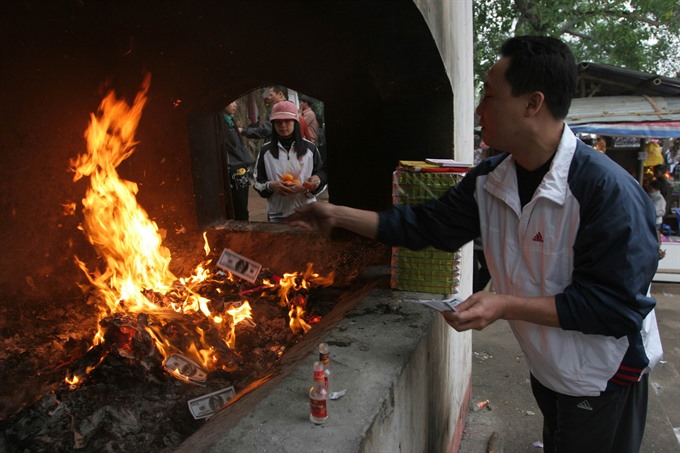 |
| Spiritual offering: A man burns votive papers at the Hương (Perfume) Pagoda on the outskirts of Hà Nội. VNS Photo Trương Vị |
An ancient tradition or a money making ploy?
The practice of burning paper has been with us for generations. But in recent years what was once just fake cash and the odd gift has developed into something much more. Paul Kennedy reports.
Take a walk down Hàng Mã Street in Hà Nội’s Old Quarter and you’ll discover many items on sale made from paper to ‘pass over’ to your departed loved ones.
Everything from cell phones to shoes, designer handbags to iPads and even washing machines, cars, houses, servants and mistresses.
If it exists in the real world, chances are, there’s a fake version for you to burn.
The paper items may be a lot cheaper than the real ones, but for families, many on low incomes, they are quite literally throwing millions of đồng on the fire.
The practice was even featured on a popular Netflix show starring British comedian Jack Whitehall who traveled around Asia with his father.
During his time in Hà Nội, they bought many novelty paper items and burned them in an oven in memory of Jack’s grandparents.
This was done purely for comedic value to give viewers a laugh at Việt Nam’s expense.
But on Hàng Mã Street, shopkeepers earn their living by selling these so-called ‘fake paper gifts’.
“The best-selling items are clothes and jewellery,” said Đào Bích Diệp as she sat in front of her store. “And items for the dead such as iPads, iPhones, many things, household items.”
The burning of items to pass to your loved ones began in China in a far more sinister way than we see today.
Back then, if a King died, his servants would be killed and buried with him to give him more people to serve him in the afterlife.
According to Võ Thị Hoàng Lan, cultural researcher from Việt Nam’s Institute of Culture and Art Study, this was also passed down to ordinary people who would be buried with their tools and everyday items when they died.
This, she said, evolved into making items from paper to pass over to the next life.
“The practice of burning votive paper in Việt Nam was influenced by China,” said Lan.
“Before 1986 [when Việt Nam began its renewal policy], there were limited types of votive papers in Việt Nam. Yet after the reform, the country’s economy developed and living conditions of people improved, they started paying more attention to their spiritual life.
“Votive papers were used for a number of occasions and therefore became increasingly popular. As demand increased, massive production of votive paper occurred.”
Vietnamese people use votive paper at Tết (Lunar New Year), communal festivals, mediumship rituals, July 15th (lunar month) – the annual Wandering Souls Day, or ghost festival, when it is believed the gates to the afterlife are opened and spirits enter the real world.
To mark this occasion people also burn gifts to offer to the dead in the hope they will use their powers to rid people of their sins and bad fortune.
So what started out as a way to save resources, destroying paper belongings instead of the real things, has evolved into the creation of just about any item needed in the afterlife.
Washing machines, air conditioning units, mopeds and even a bath. As the saying goes, everything but the kitchen sink, however if you look hard enough, you will probably find a paper kitchen sink.
And the place to look would be Song Hồ Commune in Bắc Ninh Province, some 30km east of Hà Nội. This is where most of the novelty items are created.
A tell tale sign this is no ordinary Vietnamese village is the amount of trucks you see navigating through the streets for their daily pick-ups.
The vans are loaded with boxes and boxes of fake gifts destined to go up in smoke via the stores that sell them.
Each day staff in the many businesses that operate go through between six and seven tonnes of paper to make the gifts.
Nguyễn Văn Tuân, deputy chairman of the commune People’s Committee, said locals in Bắc Ninh have been making votive paper since the 17th century.
Today, he said, around 1,200 households make up the industry producing around 2,000 tonnes each year.
Biện Thị La from Đạo Tú Hamlet, has been involved in the business for two years after marrying a man from the village.
She said: “People often buy votive paper from June to August (Lunar Year). The busiest time of the year for us is the ghost festival (July 15 Lunar month), mid-Autumn festival (August 15 Lunar month) and Tết holidays.
“People mostly buy clothes, jewellery, hats, houses or home appliances like TVs and refrigerators, etc.
“The call for burning less votive paper did affect our business for a while but then everything is back to normal. We are still selling well these days.”
Nguyễn Ngọc Tuyến has been making votive paper for more than 20 years, but only in his spare time.
“This job helps me earn extra income,” Tuyến said. “I do it in my free time besides my main job as a motorbike mechanic.
“I just make collars for shirts. It is not so complicated but as I get older, my eyes are deteriorating and it is getting more and more difficult.”
It is a delicate job as Tuyến shows. He needs pinpoint precision to make sure the holes he’s hammering are in the right spot.
Each year in Việt Nam 50,000 tonnes of fake gifts are tossed onto fires countrywide.
In Hà Nội alone, it is estimated people spend a staggering VNĐ400 billion (US$17.2 million) each year.
That’s a lot of money to effectively throw on the fire. So is it a waste? Will our ancestors really be better off with the many items offered?
“My grandfather couldn’t work the television so he would struggle with an iPad,” quipped one teenage Hanoian.
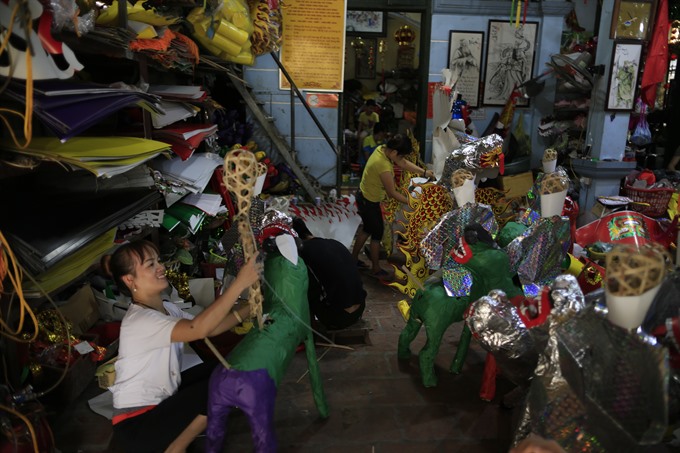 |
| Intricate: Tạ Thị Thúy Lan (left) makes an elaborate offering from paper at a small workshop in Phúc Am Village. VNS Photos Việt Thanh |
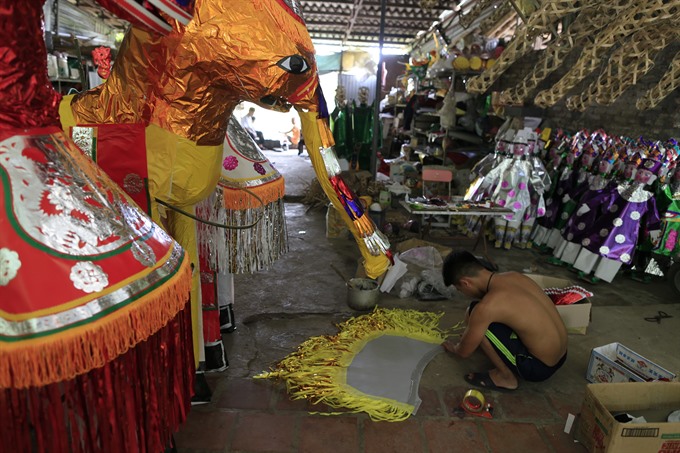 |
| Hard at work: A worker in Phúc Am village decorates a paper animal. |
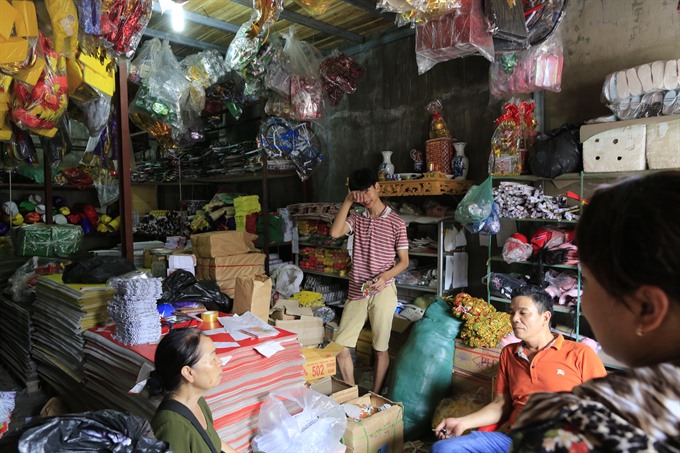 |
| Crucial job: workshops that produce paper gifts provide livelihoods for many villagers. |
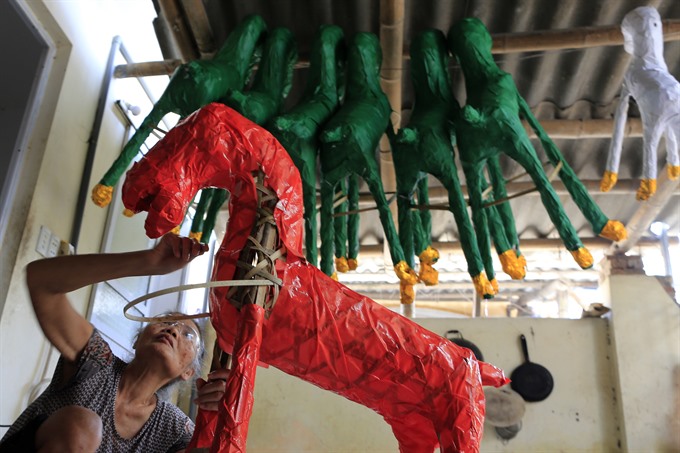 |
| Animal magic: An employee puts the finishing touches on an elaborate paper horse in Phúc Am village. |
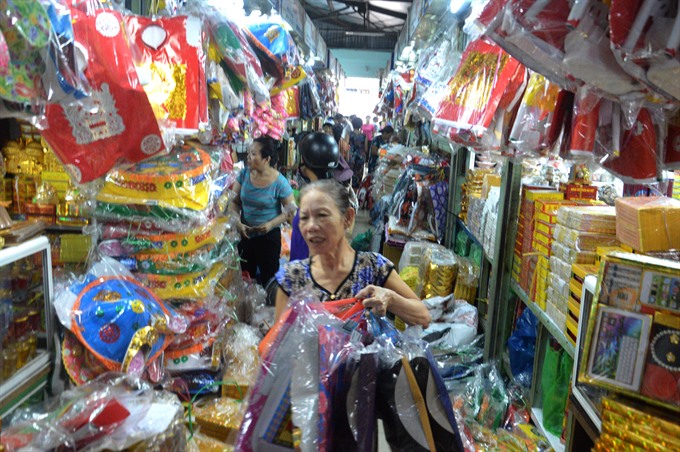 |
| For sale: Votive papers are sold in many of Hà Nội’s markets. VNA/VNS Photo Đinh Văn Nhiều |
Fire hazard
There has been talk of outlawing the practice, as it can prove to be a fire hazard. And with so many items getting burned, the environment will surely suffer.
Đặng Thành Công’s family has been making paper decorations at their factory in Thường Tín District for three generations.
He believes if the practice is outlawed, it will be the people who work in the industry that will suffer the most. Their livelihoods turned to ash.
“If this practice is banned, many families will lose their livelihoods,” he said. “Residents in this area rely on this business to keep food on the table.”
“The money they earn from the job is not much, but it gives them something to do,” he added. “Our family’s business provides jobs for 25 households.”
Researcher Lan added: “The use of votive paper is a spiritual practice rather than a Buddhism practice as many wrongly believe.”
In February, the Buddhist Sangha of Việt Nam suggested a ban, which earned support from researchers and experts but as the practice has been deeply rooted in Vietnamese people’s life, it is hard to change.
She feels the only way to reduce the practice is to educate people to understand it is irrational to use such an extravagant amount and spend so much.
In the first half of this year, the fire department were called to 13 fires caused by the burning of paper items for worship.
They caused an estimated VNĐ1 billion (US$43,000) worth of damage, an increase of VNĐ600 million ($25,000) from the same period last year.
Fire expert Nguyễn Danh Luân from the Fire Prevention, Fighting and Rescue Police Department said: “Recently, there have been many cases of fire due to burning of votive paper in the wrong places, like in the corridors and stairways of apartment buildings, on the rooftop or burning without any protective means. The fire or ashes can catch inflammable substances and cause fire.”
He urged people to burn in correct places such as ovens and copper urns and warned the people who make the votive paper to take extra care in storage and transport.
Burning items to ward off evil spirits and send gifts to deceased loved ones has been around for thousands of years.
But if it is to continue in the future, safety must come first, or those taking part may find themselves meeting their dead relatives far sooner than they wish. VNS
Additional reporting by Bảo Hoa, Hồng Vân and Thu Hà




